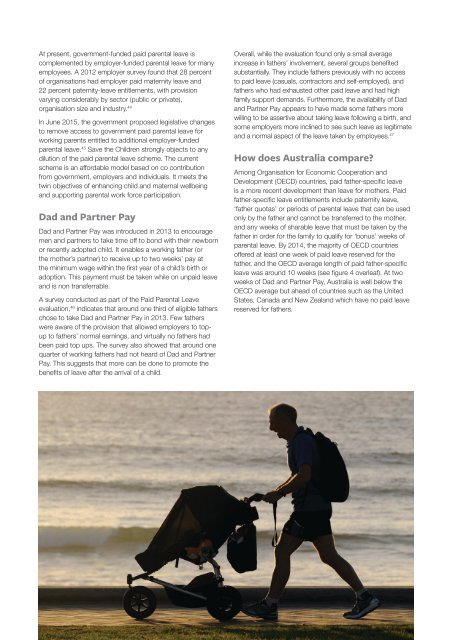State of Australia’s Fathers
1iGWp7w
1iGWp7w
- No tags were found...
Create successful ePaper yourself
Turn your PDF publications into a flip-book with our unique Google optimized e-Paper software.
At present, government-funded paid parental leave is<br />
complemented by employer-funded parental leave for many<br />
employees. A 2012 employer survey found that 28 percent<br />
<strong>of</strong> organisations had employer paid maternity leave and<br />
22 percent paternity-leave entitlements, with provision<br />
varying considerably by sector (public or private),<br />
organisation size and industry. 44<br />
In June 2015, the government proposed legislative changes<br />
to remove access to government paid parental leave for<br />
working parents entitled to additional employer-funded<br />
parental leave. 45 Save the Children strongly objects to any<br />
dilution <strong>of</strong> the paid parental leave scheme. The current<br />
scheme is an affordable model based on co contribution<br />
from government, employers and individuals. It meets the<br />
twin objectives <strong>of</strong> enhancing child and maternal wellbeing<br />
and supporting parental work force participation.<br />
Dad and Partner Pay<br />
Dad and Partner Pay was introduced in 2013 to encourage<br />
men and partners to take time <strong>of</strong>f to bond with their newborn<br />
or recently adopted child. It enables a working father (or<br />
the mother’s partner) to receive up to two weeks’ pay at<br />
the minimum wage within the first year <strong>of</strong> a child’s birth or<br />
adoption. This payment must be taken while on unpaid leave<br />
and is non transferrable.<br />
A survey conducted as part <strong>of</strong> the Paid Parental Leave<br />
evaluation, 46 indicates that around one third <strong>of</strong> eligible fathers<br />
chose to take Dad and Partner Pay in 2013. Few fathers<br />
were aware <strong>of</strong> the provision that allowed employers to topup<br />
to fathers’ normal earnings, and virtually no fathers had<br />
been paid top ups. The survey also showed that around one<br />
quarter <strong>of</strong> working fathers had not heard <strong>of</strong> Dad and Partner<br />
Pay. This suggests that more can be done to promote the<br />
benefits <strong>of</strong> leave after the arrival <strong>of</strong> a child.<br />
Overall, while the evaluation found only a small average<br />
increase in fathers’ involvement, several groups benefited<br />
substantially. They include fathers previously with no access<br />
to paid leave (casuals, contractors and self-employed), and<br />
fathers who had exhausted other paid leave and had high<br />
family support demands. Furthermore, the availability <strong>of</strong> Dad<br />
and Partner Pay appears to have made some fathers more<br />
willing to be assertive about taking leave following a birth, and<br />
some employers more inclined to see such leave as legitimate<br />
and a normal aspect <strong>of</strong> the leave taken by employees. 47<br />
How does Australia compare?<br />
Among Organisation for Economic Cooperation and<br />
Development (OECD) countries, paid father-specific leave<br />
is a more recent development than leave for mothers. Paid<br />
father-specific leave entitlements include paternity leave,<br />
‘father quotas’ or periods <strong>of</strong> parental leave that can be used<br />
only by the father and cannot be transferred to the mother,<br />
and any weeks <strong>of</strong> sharable leave that must be taken by the<br />
father in order for the family to qualify for ‘bonus’ weeks <strong>of</strong><br />
parental leave. By 2014, the majority <strong>of</strong> OECD countries<br />
<strong>of</strong>fered at least one week <strong>of</strong> paid leave reserved for the<br />
father, and the OECD average length <strong>of</strong> paid father-specific<br />
leave was around 10 weeks (see figure 4 overleaf). At two<br />
weeks <strong>of</strong> Dad and Partner Pay, Australia is well below the<br />
OECD average but ahead <strong>of</strong> countries such as the United<br />
<strong>State</strong>s, Canada and New Zealand which have no paid leave<br />
reserved for fathers.<br />
19


